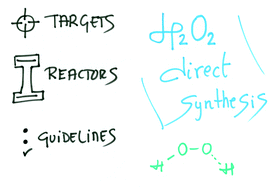Engineering in direct synthesis of hydrogen peroxide: targets, reactors and guidelines for operational conditions
Abstract
The demand for hydrogen peroxide is booming since it is considered as one of the most environmentally friendly and versatile chemical oxidants available and has a wide range of applications. The annual market, close to 3000 kt per year being produced via the auto-oxidation process (with 2-ethyl anthraquinone (traditional) or amyl anthraquinone for mega-plants), is mostly supplied by the company Solvay (30%), followed by Evonik (20%) and Arkema (13%). Nevertheless, the dream of a direct synthesis process is close to a century old and it has gained momentum in research efforts during the last decade with more than 15 groups active in the world. In this review, we focus the discussion on the targets, e.g. plant tonnage, the reactors and the most feasible industrial operational conditions, based on our experience and point of view using the chemical engineering tools available. Thus, direct synthesis can be competitive when on-site production is required and capacities less than 10 kt per year are demanded. The total investment cost should be approximately 40.3 ± 12.1 MM$ (in 2012) for a 10 kt per year size process to be comparable to the traditional process in terms of costs. Moreover, all kinds of reactors used are hereby discussed emphasizing the pros and cons; the most common ones are batch and semi-continuous modes of operation. However, at the moment, demonstrations of continuous operations as well as carefully determined kinetics are needed in order to scale up the process. Finally, operational conditions, including the catalyst composition (active metal, oxidation state and support), promoters (halides and acids–pH–isoelectric point), solvents, pressure and temperature need to be carefully analysed. In our opinion, as we try to show here, H2O2 direct synthesis is a competitive process and is ready for larger scale demonstration. Also, more than a hundred patents within the area support this claim, although the barriers of technology demonstration and further licensing are still pending.


 Please wait while we load your content...
Please wait while we load your content...